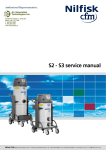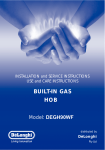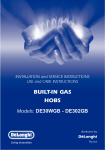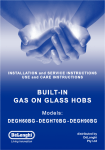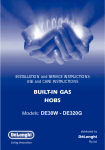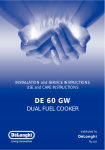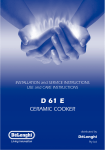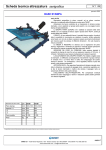Download DeLonghi T series Specifications
Transcript
INSTALLATION and SERVICE INSTRUCTIONS USE and CARE INSTRUCTIONS BUILT-IN GAS HOBS P70 series Models: DGHS70W - DGHS70WF distributed by DèLonghi Pty Ltd Dear Customer, Thank you for having purchased and given your preference to our product. The safety precautions and recommendations reported below are for your own safety and that of others. They will also provide a means by which to make full use of the features offered by your appliance. Please keep this booklet in a safe place. It may be useful in future, either to yourself or to others in the event that doubts should arise relating to its operation. This appliance must be used only for the task it has explicitly been designed for, that is for cooking foodstuffs. Any other form of usage is to be considered as inappropriate and therefore dangerous. The manufacturer declines all responsibility in the event of damage caused by improper, incorrect or illogical use of the appliance or be faulty installation. PRODUCT LABEL 2 IMPORTANT PRECAUTIONS AND RECOMMENDATIONS FOR USE OF ELECTRICAL APPLIANCES Use of any electrical appliance implies the necessity to follow a series of fundamental rules. In particular: ■ Never touch the appliance with wet hands or feet; ■ do not operate the appliance barefooted; do not allow children or other incapable people to use the appliance without supervision. The manufacturer cannot be held responsible for any damages caused by improper, incorrect or illogical use of the appliance. ■ IMPORTANT PRECAUTIONS AND RECOMMENDATIONS After having unpacked the appliance, check to ensure that it is not damaged. In case of doubt, do not use it and consult your supplier or a professionally qualified technician. Packing elements (i.e. plastic bags, polystyrene foam, nails, packing straps, etc.) should not be left around within easy reach of children, as these may cause serious injuries. ■ Do not attempt to modify the technical characteristics of the appliance as this may become dangerous to use. ■ Do not carry out cleaning or maintenance operations on the appliance without having previously disconnected it from the electric power supply. ■ After use, ensure that the knobs are in off position. ■ ■ ■ ■ ■ Do not allow children or other incapable people to use the appliance without supervision. During and after use of the hob, certain parts will become very hot. Do not touch hot parts. Keep children away from the cooker when it is in use. Some appliances are supplied with a protective film on steel and aluminium parts. This film must be removed before using the appliance. The manufacturer declines all liability for injury to persons or damage to property caused by incorrect or improper use of the appliance. 3 INSTALLATION CAUTION: ■ ■ ■ ■ ■ ■ This appliance must be installed in accordance with these installation instructions, local gas fitting regulations, municipal building codes, water supply regulations, electrical wiring regulations, AS5601 / AG 601 - Gas Installations and ony other relevant statutory regulations. This appliance shall only be serviced by authorized personnel. This appliance is to be installed only by an authorised person. Incorrect installation, for which the manufacturer accepts no responsibility, may cause personal injury of damage. Always disconnect the cooker from mains power supply before carrying out any maintenance operations or repairs. In the room where the cooker is installed, there must be enough air to allow the gas to burn correctly, according to the current local regulations. Figure 1 500 680 60 200 0 48 560 0 –2 0 –2 DIMENSIONS (Table 2): (Note: Also refer to Figure 1 side) 4 General Dimensions Width Depth Depth Below Mounting Surface Cut-out Dimensions Width Depth 680 mm 500 mm 33,7 mm 560 mm 480 mm 0 –2 0 –2 This cooktop has been designed and constructed in accordance with the following codes and specifications: AGA101 (AS 4551) Approval Requirements for Domestic Gas cooking appliances AS/NZS 3350-1 General Requirements for Domestic electrical appliances AS/NSZ 3350-2-6 Particular Requirements for Domestic electrical cooking appliances AS/NSZ 1044 Electromagnetic Compatibility Requirements. Important note: This appliance shall not be used as a space heater, especially if installed in marine craft or caravans. CLEARANCES: Installation clearances and protection of combustible surfaces shall comply with the current local regulations e.g. AG 601 (AS 5601) - Gas Installations code. 200 mm min 750 mm 450 mm Figure 2 in mm 60 m 500 mm 5 The installation shall comply with the dimensions in Figures 1 and 2, bearing in mind that: ■ A minimum clearance of 20 mm has to be kept between the bottom of the cooking hob and the top of an appliance or a shelf. To ensure this clearance mount the spacers, supplied with the appliance, as shown in the figure below. ■ Overhead clearances - In no case shall the clearance between the highest part of the hob and a range hood be less than 600 mm, or for an overhead exhaust fan, 750 mm. Any other downward facing combustible surface less than 600 mm above the highest part of the hob shall be protected for the full width and depth of the cooking surface area in accordance with local regulations in force. However, in no case shall this clearance to any surface be less than 450 mm. ■ Side clearances - Where the dimension from the periphery of the nearest burner to any vertical combustible surface is less than 200 mm, the surface shall be protected in accordance with with local regulations in force to a height of not less than 150 mm above the hob for the full dimension (width or depth) of the cooking surface area. Where the dimensions from the periphery of the nearest burner to any vertical combustible surface is less than 200mm, the horizontal surface shall be greater than 10mm below the surface of the hob, or the horizontal surface requirement above. ■ Protection of combustible surfaces - Local regulations in force specify that where required protection shall ensure that the surface temperature of the combustible surface does not exceed 65 °C above ambient. The fixing of 5 mm thick ceramic tiles to the surface or attaching fire resistant material to the surface and covering with sheet metal with minimum thickness of 0.4mm should be satisfactory. 20 mm Figure 3 6 APPLYING THE SEALS (Refer to Figures 4): – Turn the cooker top upside down. – Spread the longer seal “A” around the left, rear and right sides as shown in figure 4a. – With a cutter or a scissors cut the excess seal “C” and retain it for next use (figure 4b) Figure 4a Fig. 4b seal C seal A – Spread the seal “B” around the left, front and right edges of the cooker top as shown in figure 4c. – Spread the seal “C” along the rear edge of the cooker top as shown in figure 4d. Making sure that the beginning and the end overlap at the seal “B” (see figure 4e). Figure 4c seal C Fig. 4d seal B Figure 4e seal C seal B NT FRO seal A 7 FASTENING THE INSTALLATION BRACKETS FASTENING THE COOKER TOP (Refer to Figures 5): (Refer to Figures 5): – Insert the cooker top into the hole and position it correctly. – Adjust the position of the brackets “F and R” and tighten screws “B” to block the cooker top firmly in position. – With a sharp cutter or trimmer knife trim the excess sealing material around the edge of the cooker top. Each cooker top is provided with an installation kit including brackets and screws for fastening the top to fixture panels from 2 to 4 cm thick. – Turn the cooker top upside down and fasten the brackets “F and R” to the appropriate socket holes, without tightening the screws “B” for the moment. – Make sure that the brackets are fastened as shown in figure 5a, 5b and 5c. Figure 5a R R F NT FRO F Figure 5b Rear side Figure 5c Front side seal C B B F 40 mm max. 40 mm max. 20 mm min. 8 R 20 mm min. seal A seal A GAS SUPPLY: ■ The connection must be executed by an authorised person according to the relevant standards. ■ Before connecting the appliance to the gas main, mount the brass conical adaptor onto the gas inlet pipe, upon which the gasket has been placed (figures 6a-6b). Conical adaptor and gasket are supplied with the appliance (packed with conversion kit for use with Natural gas or Universal LPG). This appliance is suitable for use with Natural Gas or Universal LPG. (Check the “gas type” sticker attached to the appliance). ■ For Natural Gas models the gas supply is connected to the pressure regulator which is supplied with the appliance (fig. 6a). Model DGHS70W: adjust the regulator to obtain a test point pressure of 1 kPa with the two semi-rapid (SR) burners operating at the maximum. Model DGHS70WF: adjust the regulator to obtain a test point pressure of 1 kPa with the Triple-ring (TR) burner operating at the maximum.⁄ ■ For Universal LPG models the gas supply is connected to the test point adaptor which is supplied with the appliance (fig. 6b) and ensure that the supply pressure is regulated to 2.75 kPa. ■ ■ Do NOT force the ”elbow“ rotation prior to loosening nut. ■ Do NOT over tighten the nut at the ”elbow“. WARNING, This appliance IS NOT SUITABLE for installation with a hose assembly. Gas connection for NATURAL GAS Gas connection for UNIVERSAL LPG Gas inlet pipe Gas inlet pipe Test point Gasket Gasket Brass conical adaptor Brass conical adaptor (Thread tight: use suitable seal) (Thread tight: use suitable seal) Test point adaptor Gas regulator Test point Figure 6a Figure 6b 9 1. After connecting the gas supply, check the piping and connections for leaks using a soap and water solution. The presence of bubbles indicates a leak, tighten or replace connections as appropriate. Warning: Do not use any naked flame to check for leaks. 2. The operation of the appliance MUST be tested before leaving. 3. Adjust the test point pressure or supply pressure to the value which is appropriate for the gas type. 4. Turn on the appliance gas controls and light each burner. Check for a well defined blue flame without any yellow tipping. If any abnormality is evident then check that the burner cap is located properly and the injector nipple is aligned correctly. 5. Check the minimum burner setting by quickly rotating the gas control knob from the maximum to the minimum position, the flame must not go out. If adjustment is required carry out the “minimum burner setting adjustment" procedure described at page 12. 6. If satisfactory performance cannot be obtained, the installer shall check the installation and notify the local gas supply authority for a gas supply problem, or if it is an appliance problem, our Customer Service Centre should be called to obtain the nearest authorized Delonghi Service Agent. 7. Where the appliance data plate cannot be easily read with the appliance in the installed position the duplicate data plate must be attached to adjacent surface and the duplicate Universal LPG conversion label should also be included where a Universal LPG conversion has been completed. TABLE FOR THE CHOICE OF THE INJECTORS Natural gas 1.0 Test Point Pressure [kPa] 2.75 Injector Orifice Dia. Gas Consumption Injector Orifice Dia. Gas Consumption [mm] [MJ/h] [mm] [MJ/h] Auxiliary (A) 0.85 3.60 0.53 3.60 Medium-speed burner (SR) 1.12 6.30 0.70 6.30 Rapid burner (R) 1.45 10.30 0.91 10.80 Triple-ring burner (TR) 1.65 13.00 0.95 11.90 Fish burner (PS) 1.12 6.30 0.70 6.30 BURNER 10 Universal LPG CONVERSION PROCEDURE (to convert to Universal LPG) REPLACING THE INJECTORS The conversion procedure must be carried out only by an authorised person. This appliance is suitable for use with Natural gas or Universal LPG (check the “gas type” sticker attached to the appliance). The nominal gas consumption and injector size details are provided in table at page 10. To replace the injectors proceed as follows: ■ Remove pan supports and burners from the cooktop. ■ Using a spanner, remove the injector J (figs. 7a, 7b) and replace it with one according to the gas type (see tables - page 10). ■ Affix to the appliance the warning label stating that the cooktop has been converted for use with Universal LPG (supplied with the Universal LPG conversion kit.). A second Universal LPG conversion label should also be affixed to an adjacent surface along with the duplicate data plate. IMPORTANT ■ If the cooktop is suitable for use with Natural gas and must be converted for use with Universal LPG, before connecting to gas main remove the appliance gas regulator and replace with test point adaptor (see fig. 6a, 6b) ■ If the cooktop is suitable for use with Universal LPG and must be converted for use with Natural gas, before connecting to the gas main remove the appliance test point adaptor and replace with gas regulator (see figs. 6a, 6b). NOTE: Gas regulator and test point adaptor are supplied with the appliance (packed with conversion kit) The burners are designed so that regulation of primary air is not required. Figure 7a Figure 7b J J 11 MINIMUM BURNER SETTING ADJUSTMENT Check whether the flame spreads to all burner ports when the burner is lit with the gas tap set to the minimum position. If some ports do not light, increase the minimum gas rate setting. Check whether the burner remains lit even when the gas tap is turned quickly from the maximum to the minimum position. If the burner does not remain lit, increase the minimum gas rate setting. The procedure for adjusting the minimum gas rate setting is described below. For taps with adjusting screw inside the shaft (fig. 8): ✓ using a screwdriver max. diameter 3 mm turn the screw inside the tap shaft until the flame setting is correct. For taps with adjusting screw on the body (fig. 9): ✓ using a screwdriver turn screw "A" until the flame setting is correct. Normally for Universal LPG, fully tighten the adjustment screw. LUBRICATING THE GAS TAP If a gas tap is difficult to turn, disassemble it, clean it carefully with petrol and spread a little high-temperature-resistant grease on it. These operations must be performed by an Authorized person/Service agent. Note: Servicing of this appliance is only to be carried out by Authorized Person. Figure 8 Figure 9 A 12 INSTALLATION ELECTRICAL REQUIREMENTS The appliance must be connected to the mains checking that the voltage corresponds to the value given in the rating plate and that the electrical cable sections can withstand the load specified on the plate. ■ The plug must be connected to an earthed socket in compliance with safety standards. ■ If the appliance is supplied without plug, fit a standard plug which is suitable for the power consumed by the appliance. ■ The wires in the power cable are coloured in accordance with the following code: Green/Yellow = Earth, Blue = Neutral, Brown = Active. If the colours of the wires in the power cable to the appliance do not correspond with the coloured markings identifying the terminals in the junction terminal, proceed as follows: 1.The wire which is coloured green and yellow must be connected to the terminal marked E (Earth) or coloured Green. 2.The wire which is coloured blue must be connected to the terminal marked N (Nuetral) or coloured Black. 3.The wire which is coloured brown must be connected to the terminal marked L (Live) or A (Active) or coloured Red. ■ The appliance must be connected directly to the mains placing a two pole switch with minimum opening between the contacts of 3 mm between the appliance and the mains. ■ The power supply cable must not touch the hot parts and must be positioned so that it does not exceed 50°C above ambient. ■ Once the appliance has been installed, the switch or socket must always be accessible. ■ If the supply cord is damaged it must be replaced by the manufacturer or it’s Service Agent or a similarly qualified person in order to avoid a hazard. ■ N.B. The connection of the appliance to earth is mandatory. If the installation requires alterations to the domestic electrical system call a qualified electrician. He should also check that the socket cable section is suitable for the power drawn by the appliance. 13 Replacing the power cord must be done by a qualified electrician in accordance with the instructions supplied by the manufacturer and in compliance with established electrical regulations. Figure 10a 5 gas models Figure 10b 4 gas models CA CA CA N CA CA CA CA L M L M A A T T PA N CA CA PA PA PA PA PA addition for models with a gas-lighter incorporated in the knob ELECTRIC DIAGRAMS KEY (models with electric ignition) PA A M T CA Figure 10c 5 gas models PA PA PA addition for models with a gas-lighter incorporated in the knob Ignition switch Ignition coil Terminal block Earth conductor Spark electrode Figure 10d 4 gas models CA CA CA N CA CA L M N CA CA A L M A PA PA PA PA PA addition for models with a gas-lighter incorporated in the knob 14 CA CA * Ignition coil without antidisturb filter. PA PA PA PA addition for models with a gas-lighter incorporated in the knob USE and CARE CAUTION: ■ This appliance must be used only for the task it has explicitly been designed for, that is for domestic cooking of foodstuffs. Any other form of usage is to be considered as inappropriate and therefore dangerous. Do not use this appliance as a space heater. ■ Do NOT place combustible materials or products on this appliance at any time. ■ Do NOT spray aerosols in the vicinity of this appliance while it is in use. ■ Before using for the first time, clean the cooktop with warm soapy water. ■ Use the coffee pot support to ensure that small cooking utensils are stable. ■ IMPORTANT NOTE: This appliance shall not be used as a space heater, especially if installed in marine craft or caravans. 15 GAS HOBS Figure 11a Model: DGHS70W 14 13 12 11 10 GAS BURNERS 1. 2. 3. 4. 5. Right semi-rapid burner (SR) Rapid burner (R) Central triple ring burner (TR) Left semi-rapid burner (SR) Auxiliary burner (A) Natural Gas MJ/h Universal LPG MJ/h 6.30 10.30 13.00 6.30 3.60 6.30 10.80 11.90 6.30 3.60 CONTROL PANEL 10. 11. 12. 13. 14. 16 Right semi-rapid burner control knob (1) Rapid burner control knob (2) Triple-ring burner control knob (3) Left semi-rapid burner control knob (4) Auxiliary burner control knob (5) ■ This appliance is class 3 rated ■ The appliance has a safety valve system fitted (beside every burner there is the “T” probe as in fig. 16 - not confuse with the “S” electrode of the electronic ignition) the flow of the gas will stopped if and when the flame should accidentally go out. ■ The cooktop is provided with electric gas-lighting device, beside flame mum aperture or max gas flow - there is the ★ symbol). - maxi- Figure 11b Model: DGHS70WF 13 12 11 10 GAS BURNERS 1. 2. 3. 4. Semi-rapid burner (SR) Rapid burner (R) Fish burner (PS) Triple ring burner (TR) Natural Gas MJ/h Universal LPG MJ/h 6.30 10.30 6.30 13.00 6.30 10.80 6.30 11.90 CONTROL PANEL 10. 11. 12. 13. Semi-rapid burner control knob (1) Rapid burner control knob (2) Fish burner control knob (3) Triple-ring burner control knob (4) ■ This appliance is class 3 rated ■ The appliance has a safety valve system fitted (beside every burner there is the “T” probe as in fig. 16 - not confuse with the “S” electrode of the electronic ignition) the flow of the gas will stopped if and when the flame should accidentally go out. ■ The cooktop is provided with electric gas-lighting device, beside flame mum aperture or max gas flow - there is the ★ symbol). - maxi17 USING GAS BURNERS ■ Check that the electricity is switched on to allow spark ignition (models with electric ignition). ■ Make sure that all controls are turned to zero. ■ The gas flow to the burner is controlled by the knobs on the safety taps. ■ You control the flow by turning the knob indicator to line up with the following symbols: – Symbol ● : tap closed (burner off) – Symbol : High (maximum) – Symbol : Low (minimum) ■ You can control the temperature by the knob to “High” from “Minimum”. ■ To switch off, turn the knob clockwise until you hear the safety click. ■ Note that, if you are using a burner at the minimum setting, you turn the knob clockwise past the maximum setting before reaching the off position. Whenever lighting any of the burners produces an abnormal flame, switch that burner off and relight using the minimum setting. If after relighting the burner, the flame is still abnormal, turn the burner off and contact our Customer Service Centre to obtain the nearest authorized Delonghi Service Agent. In the case of a mains failure light the burner with a match or lighted taper. ■ ■ ■ ■ Note: When the cooker top is not being used, set the gas knobs to their closed positions and also close the cock valve on the gas bottle or the main gas supply line, Figure 12 18 LIGHTING THE BURNERS (fitted with safety cut-off valve) In order to light the burner, you must: 1 – Models fitted with electric lighter incorporated into the burner knobs: Turn the knob fig. 12 in anti-clockwise direction up to the maximum aperture (symbol ), push in and hold the knob; this will light the gas. 2 – Wait for about ten seconds after the gas burner has been lit before letting go of the knob (valve activation delay). 3 – Adjust the gas valve to the desired position. Important ■ If the burner flame should go out, the safety valve will automatically stop the gas flow. ■ To re-light the burner, return the knob to the closed ● position, wait for at least 1 minute and then repeat the lighting procedure. ■ N.B. If your local gas supply makes it difficult to light the burner with the knob set to maximum, set the knob to minimum and repeat the operation. ■ Whenever lighting any of the burners produces an abnormal flame, switch that burner off and relight using the minimum setting. ■ If after relighting the burner, the flame is still abnormal, turn the burner off and contact our Customer Service Centre to obtain the nearest authorized Delonghi Service Agent. 19 COOKING HINTS FOR GAS HOBS ■ The burner must be chosen according to the diameter of the pans and energy required. ■ For optimum efficiency use a wok or pan no smaller than 230mm diameter. Figure 13 do not use pans with concave or convex bases Burners Auxiliary (1) Semi-rapid Rapid Triple ring Fish burner Wok Pan diameter 12 - 14 cm 16 - 24 cm (2) 24 - 26 cm 26 - 28 cm from 12x30 to 18x38 cm max 36 cm (1): with grill for small cookware: minimum diameter 6 cm (2): front right burner, maximum diameter 22 cm 20 ■ Saucepans with handles which are excessively heavy, in relationship to the weight of the pan, are safer as they are less likely to tip. ■ Pans which are positioned centrally on burners are more stable than those which are offset. ■ It is far safer to position the pan handles in such a way that they cannot be accidentally knocked. ■ When deep fat frying fill the pan only one third full of oil. ■ DO NOT cover the pan with a lid and DO NOT leave the pan unattended. ■ In the unfortunate event of a fire, leave the pan where it is and turn off all controls. ■ Place a damp cloth or correct fitting lid over the pan to smother the flames. ■ DO NOT use water on the fire. ■ Leave the pan to cool for at least 30 minutes. GRILL FOR SMALL COOKWARE ■ (fig. 14) Put it on the auxiliary burner (the smallest) grid when small cookware is being used to prevent the cookware from tipping over. Figure 14 21 CORRECT USE OF TRIPLE-RING BURNER ■ The flat-bottomed pans are to be placed directly onto the pan-support. ■ To use the WOK, you must place the wok stand in the CORRECT position as shown in fig. 15. Figure 15 WRONG 22 CORRECT Cleaning and Maintenance GENERAL TIPS ■ ■ ■ ■ ■ Before cleaning the hob switch it off and wait for it to cool down. Clean with a cloth, hot water and soap or liquid detergent. Do not use products which are abrasive, corrosive or chlorine based. Do not use steel pads. Do not leave acid or alkaline substances (vinegar, salt, lemon juice, etc.) on the hob. ENAMELLED PARTS ■ ■ All the enamelled parts must be washed only with a sponge with soapy water or other non-abrasive products. Dry carefully. STAINLESS STEEL HOB ■ ■ ■ Clean with special products which are available on the market. Dry preferably with chamois leather. Note: regular use will cause discolouring around the burners, because of the high flame temperature. BURNERS AND GRIDS ■ ■ ■ ■ These pieces can be removed and washed with suitable products. After cleaning burners and spreaders dry them well and replace them correctly. In appliances with electric ignition keep the electrode clean so that the sparks always strike. Note (models with electric ignition): To avoid damage to the electric ignition do not use it when the burners are not in place. GAS TAPS ■ ■ Regular lubrication of the gas taps must only be performed by Authorized person. If the gas taps are not working properly, call our Customer Service Centre to obtain the nearest Authorized Delonghi Service Agent. 23 CORRECT POSITIONING OF THE BURNERS ■ It is very important to check that spreader “F” and cap “C” of the burner (see Figures 16 and 17) are perfectly in place because if they move out of place serious problems could arise. ■ Make sure that electrode "S" (Fig. 16) is kept clean so that the sparks always strike. ■ Make sure that probe “T” (fig. 16) next to each burner is kept clean to ensure correct operation of the safety valves. ■ Both the probe and ignition plug must be very carefully cleaned. ■ Note: To avoid damage to the electric ignition do not use it when the burners are not in place. Figure 16 Figure 17 C F T S 24 CORRECT POSITIONING OF THE TRIPLE-RING BURNER ■ The triple ring burner must be correctly positioned (see fig. 20); the burner rib must be located in position as shown by the arrow (see fig. 18). ■ The burner correctly positioned must not rotate (fig. 19). ■ Then position the cap “A” and the ring “B” (fig. 19). Figure 18 Figure 20 Figure 19 A B 25 CORRECT POSITIONING OF THE FISH BURNER (model DGHS70WF) ■ This burner must be correctly positioned as shown in the figure 21. Figure 21 S T 26 SERVICE AND MAINTENANCE If the ignition spark fails to ignite or does not light the gas, check the following items before calling our Customer Service Centre to obtain the nearest Authorised Delonghi Service Agent: ■ ■ ■ Burner is reassembled and located correctly. Spark electrode and white ceramic are clean and dry. 240 VAC power supply is connected. Contact the local gas utility or our Customer Service Centre to obtain the nearest Authorized Delonghi Service Agent. ■ ■ ■ You can smell gas when all burners are turned on. The burners do not remain alight at the minimum marked setting. The burner flame is yellow or emits an unusual odour. Note that a bi-annual inspection of the appliance by an authorized service agent or your local gas utility will ensure many years of trouble free operation of your appliance. Servicing the appliance: Service may be obtained by contacting our Customer Service Centre to locate the nearest Authorised Delonghi Service Agent: LUBRICATION OF THE GAS TAPS If the gas tap becomes stiff, it is necessary to dismantle it carefully and clean it with petroleum spirit. Specialist high temperature resistant grease should be used to lubricate the tap before replacing. The operations must be carried out by an authorised person/service agent. Figure 22 Gas taps fitted with flame failure device 27 Descriptions and illustrations in this booklet are given as simply indicative. The manufacturer reserves the right, considering the characteristics of the models described here, at any time and without notice, to make eventual necessary modifications for their construction or for commercial needs. Cod. 1102193 - ß6































